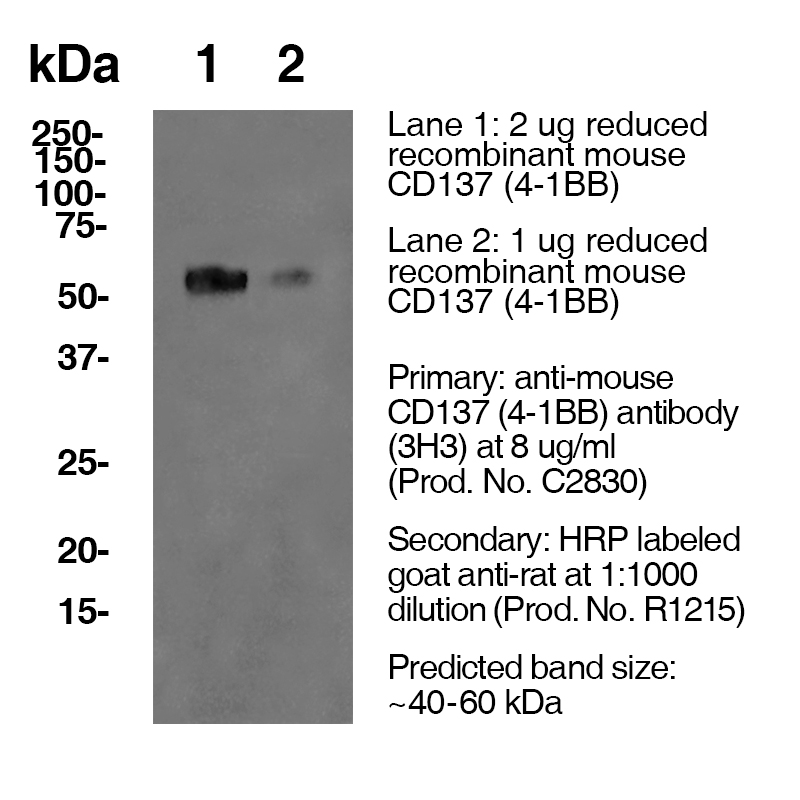Anti-Mouse CD137 (4-1BB) [Clone 3H3] — Purified in vivo GOLD™ Functional Grade
Anti-Mouse CD137 (4-1BB) [Clone 3H3] — Purified in vivo GOLD™ Functional Grade
Product No.: C2830
Clone 3H3 Target 4-1BB Formats AvailableView All Product Type Monoclonal Antibody Alternate Names TNFRSF9, 4-1BB, CD137 Antigen, T-Cell Antigen, ILA, CD137 Isotype Rat IgG2a κ Applications ELISA , FA , in vivo , WB |
Data
Antibody DetailsProduct DetailsReactive Species Mouse Host Species Rat Recommended Isotype Controls Recommended Isotype Controls Recommended Dilution Buffer Immunogen Recombinant Mouse CD137 human Fc fusion protein Product Concentration ≥ 5.0 mg/ml Endotoxin Level < 1.0 EU/mg as determined by the LAL method Purity ≥95% monomer by analytical SEC ⋅ >95% by SDS Page Formulation This monoclonal antibody is aseptically packaged and formulated in 0.01 M phosphate buffered saline (150 mM NaCl) PBS pH 7.2 - 7.4 with no carrier protein, potassium, calcium or preservatives added. Due to inherent biochemical properties of antibodies, certain products may be prone to precipitation over time. Precipitation may be removed by aseptic centrifugation and/or filtration. Product Preparation Functional grade preclinical antibodies are manufactured in an animal free facility using in vitro cell culture techniques and are purified by a multi-step process including the use of protein A or G to assure extremely low levels of endotoxins, leachable protein A or aggregates. Storage and Handling Functional grade preclinical antibodies may be stored sterile as received at 2-8°C for up to one month. For longer term storage, aseptically aliquot in working volumes without diluting and store at ≤ -70°C. Avoid Repeated Freeze Thaw Cycles. Country of Origin USA Shipping Next Day 2-8°C RRIDAB_2737470 Applications and Recommended Usage? Quality Tested by Leinco WB ELISA Additional Applications Reported In Literature ? in vivo 4-1BB stimulation in vitro 4-1BB stimulation Each investigator should determine their own optimal working dilution for specific applications. See directions on lot specific datasheets, as information may periodically change. DescriptionDescriptionSpecificity 4-1BB antibody (clone 3H3) recognizes an epitope on mouse 4-1BB. Background 4-1BB (CD137) is a 39 kD transmembrane protein that is a member of the tumor necrosis factor (TNF) receptor family and is a co-stimulatory molecule that plays a role in T-cell-mediated proliferative response. When binding its ligand, CD137 provides costimulatory signals to both CD4 and CD8 T cells via the activation of NF-B, c-Jun and p38 downstream pathways. Crosslinking of CD137 boosts T cell proliferation, IL-2 secretion, survival and cytolytic activity. Furthermore, it can increase immune activity to eliminate tumors in mice. Agonistic 4-1BB antibodies have been reported to stimulate a more intense immune system attack on cancers. Antigen Distribution 4-1BB is expressed on activated B cells and T cells, macrophages, and dendritic cells. Ligand/Receptor 4-1BB (CDw137) PubMed NCBI Gene Bank ID UniProt.org Research Area Costimulatory Molecules . Immunology Leinco Antibody AdvisorPowered by AI: AI is experimental and still learning how to provide the best assistance. It may occasionally generate incorrect or incomplete responses. Please do not rely solely on its recommendations when making purchasing decisions or designing experiments. Clone 3H3 is a well-characterized agonistic monoclonal antibody targeting mouse CD137 (4-1BB). It is widely used in in vivo mouse studies for several applications:
Overall, clone 3H3 is a valuable tool for studying immune responses and developing immunotherapeutic strategies. Commonly used antibodies and proteins studied with 3H3 (an agonistic anti-4-1BB/CD137 antibody) in the literature include other co-stimulatory and checkpoint pathway markers such as anti-PD-1, anti-TIGIT, the anti-4-1BB antibody LOB12.3, and cellular markers for immune profiling like CD25, NK1.1, CD44, CD49b, CD62L, CD8β, CD3ε, CD4, Gr-1, and OX40. Key examples from published studies:
Summary table of commonly co-used antibodies/proteins with 3H3:
Most commonly, the focus is on checkpoint inhibitors, co-stimulatory agonists, and comprehensive immune profiling panels when 3H3 is used to dissect immune responses in the context of cancer immunotherapy or T cell biology. Clone 3H3, an antibody targeting CD137 (4-1BB), has been widely studied in scientific literature, particularly in the context of cancer immunotherapy. Here are the key findings from its citations:
These findings highlight the potential of clone 3H3 in cancer immunotherapy by augmenting immune responses, although its use must be balanced with potential inflammatory side effects. Dosing regimens of clone 3H3, an agonistic anti-mouse CD137 (4-1BB) antibody, vary considerably across different mouse models based on factors such as mouse strain, disease type, experimental goal, and isotype version. Essential context and details:
Additional relevant information:
In summary, 3H3 dosing regimens range widely (typically 50–200 μg/mouse i.p., given every 3–7 days), with adjustments depending on model, strain, and experimental context. For precise protocols, consulting the original published experimental setup relevant to the disease model is essential, as dose and schedule are often optimized empirically for each study. References & Citations1. Shan B et al. (2008) Cell Mol Immunol. 5: 379 2. Kwan BS et al. (1996) Cell Immunol. 169: 91 3. Kwan BS et al. (1998) Eur J Immunol. 28: 881 4. Kwan BS et al. (2009) J Immunol. 182: 4107 Technical ProtocolsCertificate of Analysis |
Related Products
Prod No. | Description |
|---|---|
S211 | |
R1364 | |
I-1177 | |
C247 | |
F1175 | |
R1214 | |
S571 |
Formats Available
 Products are for research use only. Not for use in diagnostic or therapeutic procedures.
Products are for research use only. Not for use in diagnostic or therapeutic procedures.



